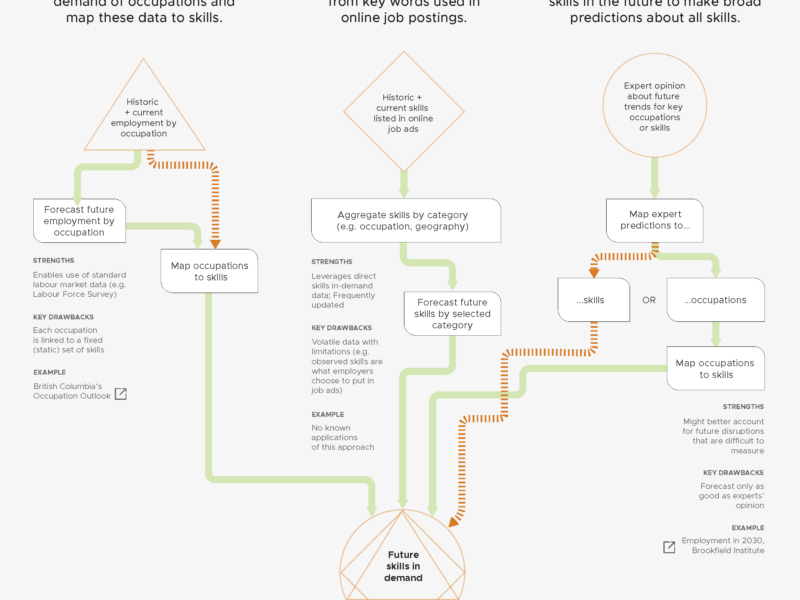How to Forecast Skills in Demand: A Primer
Driving forces in the world of work—including population ageing, climate change, globalization and technology, among others—have been disrupting employment for decades. The quantity and quality of jobs have evolved rapidly as workplaces adapt to new ways of working. In the past year, all of these changes have been exacerbated by the onset of the COVID-19 pandemic.
This paper analyzes three approaches to forecasting in-demand skills that equips individuals and organizations to make sound decisions in training and employment development.
Key Takeaways
Executive Summary
The demand for future skill needs is intensifying
For training and education systems and workforce development strategies to succeed, educators, employers, students (etc.) must understand the future of the labour market. How many jobs will be needed? Where will the jobs be, and what education and training levels will be required? To add to this complexity, while education remains a fundamental pillar of workforce development, data and information on skills are now considered essential to ensuring the country’s future success. Accordingly, anticipating Canada’s future skills needs is a key consideration in this regard.
Three broad approaches to forecasting in-demand skills come with their own strengths and limitations. These approaches include:
- forecasting employment in occupations and mapping these data to skills
- forecasting skills based on those listed in online job postings
- modelling expert opinions about the future trajectories of skills to make broad predictions about those that will be in demand
Becoming conversant with these general approaches to skills forecasting and understanding the benefits and limitations of each will enable individuals and organizations to make better investment decisions in training and education today.
Knowledge of skills in demand is not the same as a shortfall in skills
We can derive skills supply information by directly measuring individual skills through testing. The most well-known source of test-derived skills information is the Programme for the International Assessment of Adult Competencies (PIAAC), which rigorously tests individuals for a small number of general skills (e.g., literacy, numeracy and problem-solving) in a technology-rich environment. Given that these tests are done infrequently and that test specifications change over time, it is not clear that PIAAC and similar supply information can be used as inputs in forecasting models. Separately, there is some possibility of extracting skills information from resumés posted online, but this raises ethical issues about accessing and using personal data. Ultimately, skills supply forecasts represent an important source of information that needs to be developed with respect to the specific types of supply-side data available.
The way forward: Finding balance
There is no “silver bullet” approach. Given the unique lens used by each, there is value in drawing insights from all three and using them in a complementary fashion. Further research is needed to explore the possibility of combining the strengths of the various approaches. One example might be using data from online job postings to map expert opinions to the prospects for changing skills demand. Another might be mapping occupation outlooks to skills using the work requirements identified in online job postings. As a final example, one could use expert opinions to develop scenario-based occupation outlooks in which the scenarios reflect qualitative assessments of future shocks by experts.
To support the development of robust skills-demand forecasts, the Future Skills Centre and the Labour Market Information Council have launched a project that aims to equip front-line career service organizations with tools and insights to help Canadians navigate their career choices. Part of that work will entail testing and piloting new methods, including leveraging online job-posting data and other approaches, to better understand future skill requirements. Ultimately, drawing on the strengths of different and complementary approaches is the best way forward.





